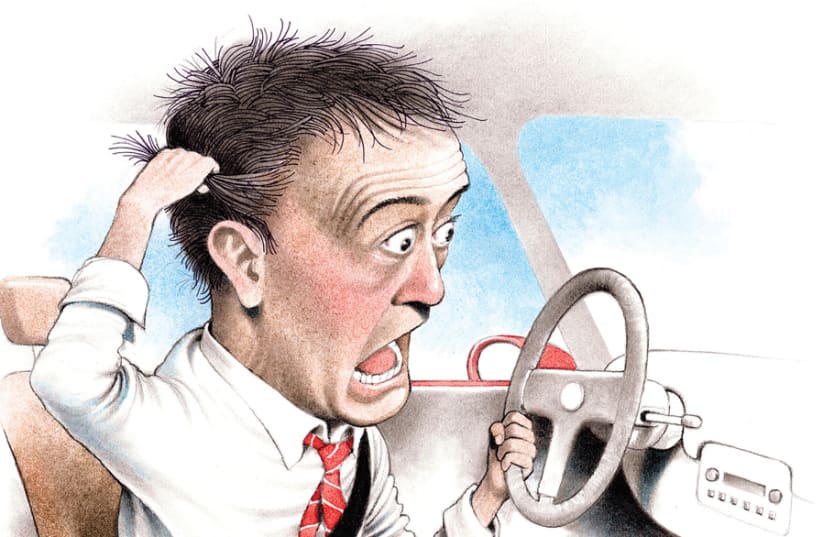I tried to speed up, but the SUV matched my every move, getting even closer (if that was possible). I felt my pulse quicken, my skin flush, lips tighten. If I hadn’t been alone in the car, I would have let loose a string of choice curses at whomever was in the passenger seat, if only to demonstrate that I would be no freier (Yiddish for “sucker”).
Instead, I pulled over to the adjoining lane. The SUV zoomed past me, but then, in a too typical example of bad behavior, abruptly switched into my new lane and jammed on his brakes. He was going to show me who was the boss. I did the same – fortunately, there was no one behind me – before the SUV sped up and was gone.
The whole incident lasted less than a minute. But the feeling of anger, frustration and a desire to “get back” at my multiton vehicular bully remained with me for the rest of the trip home.
I was annoyed but not afraid of the SUV driver. Aggressive behavior behind the wheel, while sadly de rigueur in Israel, rarely ends in the kind of road rage that made headlines in 1987 Los Angeles, when five people were killed by angry drivers packing heat on the city’s freeways in the course of several months that summer.
“People are calling up from other states wondering if it’s safe to travel to Disneyland!” lamented California Highway Patrol Chief Edward Gomez at the time.
Incidents around road rage seem to fall squarely in the category of “unnecessary and avoidable.” If only drivers would tamp down their anger, our highways would be secure.
But rage in general is not only inevitable, it appears to be evolutionarily selected, says Robert Wright, author of The Moral Animal.
While “crazy things like road rage don’t seem to make a lot of sense,” Wright explained during an interview on WYNC radio, the same emotion carried a certain logic in a hunter-gatherer environment. “Rage demonstrates that you cannot be taken advantage of. Someone tries to steal a possession, a mate or whatever, you show you’re willing to fight.”
You don’t have to win, Wright added. “Even if you lose the fight, you’ve demonstrated that there’s a cost.”
The problem is, when you take your rage out on the highway, you’re not sending a signal to anyone you’ll likely ever meet again.
“They’re not living right next door to you; you won’t see them around the campfire that night,” Wright explained.
Which is why rage has the propensity to “misfire in the modern environment,” Wright said. We try our hardest to be good mannered in our face-to-face dealings, only to see it blow up with a speeding stranger.
BUT IF rage is an integral part of our prehistoric psyche, is there a way to “use” it in more productive ways – far from the Jerusalem-Tel Aviv highway? In the right context, can a little rage improve our relationships? Make us more productive?
Roey Tzezana thinks so. The Israeli futurist, nanotechnologist and author of The Guide to the Future, says that rage channeled correctly can fuel creativity.
“We need to create a culture and a society where people aren’t afraid to disagree,” Tzezana says.
And which country has the highest percentage of people with such chutzpah? Hello Start-Up Nation.
Tzezana has been doing impromptu “field research” on the role of rage, while living in the US for the past few years, where his wife is pursuing her doctorate.
Tzezana recalls a party where “one Israeli got into a fight with another Israeli. It was a real shouting match. The Americans were starting to bite their fingernails. ‘Those guys will pull out their knives,’ they feared.”
At the end, though, the two Israelis agreed to disagree. They demonstrated their rage, signaled their passions, then “shook hands and had a drink,” Tzezana remembers.
As an immigrant to Israel, it can be hard to stomach the degree of aggressiveness in everyday life here – whether that’s in the supermarket, at a concert or dealing with know-it-all bureaucrats.
What Tzezana is saying is that the same aggression that makes me sometimes want to flee to a more “polite” country could be regarded in a more positive light. We all need to “argue more like Israelis,” Tzezana quips.
How might we get there? Tzezana has a simple way to start: ban suits and ties at conferences, he says.
“Ties constrict our creativity. They enforce thinking in old ways, of acknowledging hierarchy. If you want to be a truly innovative society, people must be able to argue and shout at each other – without ties.”
The perpetrators of road rage don’t generally wear ties, and it can be a fine line between discomfort and ingenuity. But perhaps with a little creative rage of our own, we’ll come up with new ways to disincentivize counterproductive signaling to strangers.
Rage is not an emotion we can simply will away. Nor should we want to.
So here’s a challenge: What should we get angry about next?
The writer’s book, Totaled: The Billion-Dollar Crash of the Startup that Took on Big Auto, Big Oil and the World, is available on Amazon and other online booksellers.
